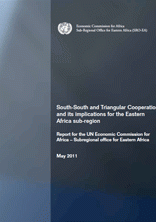South-South and Triangular Cooperation and its implications for the Eastern Africa sub-region

A vast region, with a number of politically unstable states, eastern Africa nevertheless has displayed potential in grappling with some of those challenges and creating an integrated market to help leverage development. South-South and Triangular Cooperation are notable features on the landscape of the region. Driven by the opportunities that the continent presents, new Southern emerging powers (from China to Saudi Arabia) are accelerating their engagement in east Africa. While not altruistic in this pursuit, these states nevertheless have provided both educational and technical assistance, as well as muchneeded investment in infrastructure. Triangular cooperation is also helping to deepen collaboration between Southern states by providing additional resources by partnering with the North.
East Africa can derive much benefit from this and already a number of projects on the ground bear testament to that. The examples set out in the report reflect a diversity of activities in a number of sectors, from training and education, to agriculture, ICT and roads and railways. An innovative project on e-schools has alerted many governments to the importance and utility of the internet and ICT in their strategic plans on education, while in previously conflict-torn Burundi, Rwanda and South Sudan, South Africa is working with the public administration training outfits to build an efficient public service. These projects may not be big in size or scale, but are often niche initiatives that allow innovation in a particular sector. One of the most notable is the Pan African e network for telemedicine and tele-education, where India is an important partner.